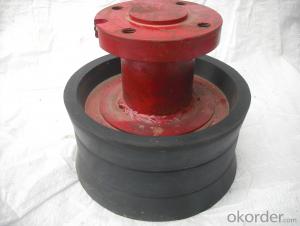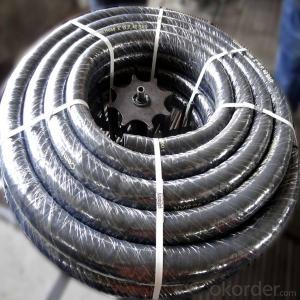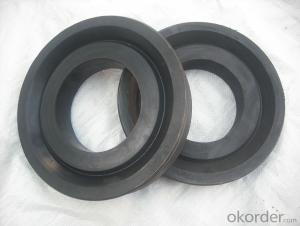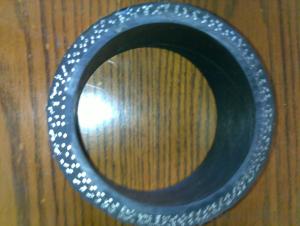ZOOMLION RUBBER PISTON DN220 WITH HIGH QUALITY
- Loading Port:
- Tianjin
- Payment Terms:
- TT OR LC
- Min Order Qty:
- 1 set
- Supply Capability:
- 500 set/month
OKorder Service Pledge
OKorder Financial Service
You Might Also Like
Zoomlion concrete pump rubber piston DN220
Schwing/ Sany/PM/Zoomlion concrete pump rubber piston
name | Concrete pump piston |
size | DN200 for Schwing DN230 for Schwing DN200 for PM entirety piston DN230 for PM entirety piston DN180 for Zoomlion piston DN200 for Zoomlion piston DN220 for Zoomlion piston DN230 for Zoomlion piston DN180 for Sany piston DN195 for Sany piston DN200 for Sany piston DN230 for Sany piston DN260 for Sany piston DN280 for Sany piston Other sizes and types upon request |
Material | PUR Polyurethane,natural rubber |
Applacation | Used in concrete pump truck,concrete pump,Hydrulic ram system in Construction work equipment
|
Serving brands of mounted truck concrete pump and concrete pump | Sany ,PM, Zoomlion,Schwing,CIFA and so on |


- Q: What is the function of a concrete pump hopper grate lever?
- The concrete pump hopper grate lever serves the purpose of regulating the opening and closing of the hopper grate on a concrete pump. The hopper grate, which is a metal grid covering the chamber where the concrete is loaded before being pumped, is controlled by this lever. This lever grants the operator the ability to effortlessly adjust the position of the grate. It can be opened to allow the concrete to flow into the hopper or closed to prevent any debris or foreign objects from entering the pump system. The control provided by the lever is essential for ensuring the smooth and efficient operation of the concrete pump. Any obstructions or contaminants in the hopper have the potential to cause damage to the pump or compromise the quality of the concrete being pumped. By utilizing the hopper grate lever, the operator can maintain a constant flow of concrete into the pump and ensure that only clean and properly mixed concrete is used. Moreover, the lever serves as a safety precaution, allowing the operator to swiftly close the grate in the event of an emergency or malfunction. In conclusion, the concrete pump hopper grate lever plays a critical role in the effective functioning and upkeep of a concrete pump system.
- Q: Can I get spare parts for both concrete pumps with and without emergency stop systems?
- Yes, you can get spare parts for both concrete pumps with and without emergency stop systems. Most manufacturers and suppliers of concrete pumps offer a wide range of spare parts that are compatible with various models and types of pumps. These spare parts include components like hoses, pipes, valves, seals, and other essential parts that may need replacement due to wear and tear or damage. Whether your concrete pump has an emergency stop system or not, you should be able to find the necessary spare parts to keep your pump running smoothly. However, it is important to note that the availability of specific spare parts may vary depending on the brand, model, and age of your concrete pump. To ensure you get the right spare parts, it is advisable to consult the manufacturer or supplier of your concrete pump. They can provide you with a comprehensive list of spare parts and guide you in selecting the appropriate ones for your specific pump. Additionally, they may also be able to assist you with any technical support or troubleshooting related to your concrete pump.
- Q: Are there any specific guidelines for the installation of seal kits or O-rings in concrete pump spare parts?
- Yes, there are specific guidelines for the installation of seal kits or O-rings in concrete pump spare parts. Here are some general guidelines to follow: 1. Safety precautions: Always ensure that the concrete pump is turned off and depressurized before attempting to install any seal kits or O-rings. Wear appropriate safety gear, such as gloves and goggles, to protect yourself during the installation process. 2. Preparation: Thoroughly clean the area where the seal kits or O-rings will be installed. Remove any debris or old seal remnants to ensure a clean and smooth surface for installation. 3. Inspection: Before installing new seal kits or O-rings, inspect them for any defects or damage. If any issues are found, replace the faulty parts with new ones. 4. Lubrication: Apply a small amount of compatible lubricant or hydraulic oil to the seal kits or O-rings to aid in their installation and prevent damage during the process. Be sure to use a lubricant that is compatible with the materials used in the seal kits or O-rings. 5. Proper alignment: Carefully align the seal kits or O-rings with their respective grooves or seating areas in the concrete pump. Ensure that they are properly seated and positioned before proceeding. 6. Correct installation technique: Use the appropriate tools and techniques to install the seal kits or O-rings. Avoid excessive force or bending, as this can lead to damage or improper sealing. 7. Testing: After the installation is complete, test the concrete pump to ensure that the seal kits or O-rings are functioning properly. Check for any leaks or abnormal behavior during operation. 8. Regular maintenance: Once the seal kits or O-rings are installed, it is important to regularly inspect and maintain them to ensure their longevity and optimal performance. Follow the manufacturer's recommended maintenance schedule and guidelines for best results. It is important to note that these guidelines are general in nature and may vary depending on the specific make and model of the concrete pump. Therefore, it is always recommended to consult the manufacturer's instructions and guidelines for the particular seal kits or O-rings being installed.
- Q: What is the role of a concrete pump spectacle plate?
- The role of a concrete pump spectacle plate is to provide a stable and secure platform for the concrete pump to rest on during operation. It acts as a support base for the pump, ensuring that it remains steady and balanced while pumping concrete. The spectacle plate is typically made of durable materials such as steel or alloy, capable of withstanding the weight and pressure exerted by the pump. Its design includes various features such as slots or holes to allow for the attachment of accessories like clamps or pipes, enabling the smooth and efficient transfer of concrete from the pump to the desired location. Additionally, the spectacle plate may also have adjustable elements to allow for positioning and alignment adjustments, ensuring accurate placement of the concrete. Overall, the spectacle plate plays a vital role in maintaining the stability and functionality of the concrete pump, contributing to the successful completion of construction projects.
- Q: How can you determine when a concrete pump pipe needs to be replaced?
- Determining whether a concrete pump pipe requires replacement involves several factors to consider. 1. Visual Examination: Thoroughly inspect the pipe visually, searching for cracks, damages, or indications of wear and tear. Pay close attention to the pipe's ends where it connects to the pump and nozzle, as these regions are more susceptible to damage. 2. Performance Assessment: Observe the concrete pump's performance. If there is a decline in pumping efficiency, such as reduced output or difficulties in maintaining pressure, it may indicate a pipe problem. Furthermore, excessive leakage or blockages in the pipe could signify the need for replacement. 3. Age and Usage: Take into account the pipe's age and the extent of its usage. Concrete pump pipes have a limited lifespan, and over time and extensive use, they can deteriorate and lose their structural integrity. If the pipe is old and has undergone substantial use, it might be time for a replacement. 4. Regular Maintenance and Repairs: Frequent repairs or maintenance on the pipe could suggest that it is approaching the end of its lifespan. While regular maintenance can extend the pipe's life, if repairs are becoming more frequent and costly, it may be more cost-effective to replace it. 5. Safety Considerations: Prioritize safety when deciding on pipe replacement. If there are significant structural issues or concerns about the pipe's ability to handle pressure, it is crucial to replace it to prevent potential accidents or hazardous situations. Ultimately, the decision to replace a concrete pump pipe should be based on a combination of visual inspection, performance evaluation, age, usage, regular maintenance, and safety considerations. It is advisable to seek guidance from a professional or experienced technician who can assess the pipe's condition and offer expert advice on whether replacement is necessary.
- Q: What are the signs of a faulty concrete pump control box?
- Some signs of a faulty concrete pump control box may include malfunctioning buttons or switches, erratic or inconsistent pump operation, failure to start or stop the pump, and abnormal or unusual sounds coming from the control box. Additionally, if there are any visible signs of damage, such as loose wires or burnt components, it could indicate a problem with the control box.
- Q: Are there any specific guidelines for the installation of control panels or electronic components in concrete pump spare parts?
- Yes, there are specific guidelines for the installation of control panels or electronic components in concrete pump spare parts. When installing control panels or electronic components in concrete pump spare parts, it is important to consider the following guidelines: 1. Protection from Moisture: Concrete pump spare parts are exposed to moisture, which can be detrimental to electronic components. It is advisable to install control panels or electronic components in waterproof or moisture-resistant enclosures to prevent damage from water or humidity. 2. Vibration and Shock Absorption: Concrete pump spare parts are subject to vibration and shock during operation. To prevent damage to control panels or electronic components, it is recommended to use shock-absorbing mounts or vibration-resistant enclosures to minimize the impact of these forces. 3. Temperature Control: Concrete pump spare parts can be exposed to extreme temperatures, both hot and cold. It is crucial to ensure that control panels or electronic components are installed in a temperature-controlled environment. This may involve using insulation or cooling systems to maintain a suitable operating temperature range. 4. Wiring and Connections: Proper wiring and connections are essential for the functioning of control panels or electronic components. It is important to follow the manufacturer's instructions and guidelines for wiring, ensuring that connections are made securely and that proper insulation and protection are provided to prevent short circuits or electrical hazards. 5. Accessibility and Maintenance: Control panels or electronic components should be installed in a manner that allows easy accessibility for maintenance and repairs. It is recommended to leave enough space around the components for easy inspection, servicing, and replacement if necessary. By adhering to these guidelines, the installation of control panels or electronic components in concrete pump spare parts can be done in a manner that ensures their long-term functionality and durability.
- Q: What is the purpose of a concrete pump hydraulic oil cooler?
- The primary function of a concrete pump hydraulic oil cooler is to keep the hydraulic oil in the system at the ideal temperature. The hydraulic oil powers the hydraulic system of the pump, which is responsible for operating different components like pistons, cylinders, and valves. While the pumping process is ongoing, the constant movement and pressure can cause the hydraulic oil to heat up. If the oil gets too hot, its viscosity decreases, which negatively impacts the overall efficiency and performance of the pump. Additionally, excessive heat can cause the hydraulic oil to deteriorate and break down, resulting in increased wear and tear on the pump's components. To prevent these problems, a concrete pump hydraulic oil cooler is utilized. It typically functions as a heat exchanger, transferring heat from the hydraulic oil to a cooling medium like air or water. This helps regulate the temperature of the hydraulic oil and keeps it within a safe operating range. By maintaining the optimal temperature, the hydraulic oil cooler guarantees that the hydraulic system functions efficiently and effectively. It also helps extend the pump's lifespan by reducing the risk of overheating and excessive component wear. Moreover, it preserves the quality of the hydraulic oil, allowing it to retain its lubricating properties and prevent any potential harm to the system. In conclusion, the goal of a concrete pump hydraulic oil cooler is to control the temperature of the hydraulic oil to optimize the performance, efficiency, and longevity of the pump's hydraulic system.
- Q: How can one ensure proper alignment and positioning of concrete pump spare parts during installation?
- Achieving the desired alignment and positioning of concrete pump spare parts during installation is crucial for the pump's efficient and safe operation. Here are some important steps to follow: 1. Familiarize yourself with the manufacturer's instructions: Before starting the installation process, carefully read and understand the instructions and guidelines provided by the manufacturer. These instructions will give you specific information on how to align and position the spare parts for your concrete pump model. 2. Prepare the work area properly: Clear any debris, dust, or obstacles from the work area that could hinder the installation process. A clean and organized work environment will make it easier to accurately position and align the spare parts. 3. Use appropriate lifting equipment: Concrete pump spare parts can be heavy and require special lifting equipment to prevent damage or injuries. Utilize cranes, hoists, or forklifts to lift and position the spare parts accurately and safely. 4. Employ precise measuring tools: Invest in high-quality measuring tools like laser levels, alignment guides, and precision measuring tapes. These tools will help you ensure precise alignment and positioning of the spare parts during installation. 5. Verify dimensions and specifications: Before installing any spare part, compare the dimensions and specifications provided by the manufacturer with the actual part. This will help you identify any discrepancies or potential issues that need to be addressed before installation. 6. Follow a systematic installation process: Begin with the main components of the concrete pump and gradually proceed to the spare parts. Follow a step-by-step approach, meticulously aligning and positioning each spare part according to the manufacturer's instructions. 7. Seek professional assistance if necessary: If you are uncertain about the proper alignment and positioning of certain spare parts, don't hesitate to seek professional assistance. Consulting experienced technicians or contacting the manufacturer's customer support can provide valuable guidance and ensure correct installation. 8. Perform a final inspection: Once all the spare parts are installed, conduct a thorough inspection to verify the alignment and positioning. Check for any visible gaps, misalignments, or irregularities. Immediately address any issues to ensure the proper function and longevity of the concrete pump. By following these steps and paying attention to detail, you can guarantee the proper alignment and positioning of concrete pump spare parts during installation, resulting in a dependable and efficient pump system.
- Q: How long does it take to replace a specific concrete pump spare part?
- The duration required to replace a specific spare part for a concrete pump can vary based on several factors. Initially, the replacement time will be influenced by the complexity and size of the part. Smaller and simpler parts can be swapped out relatively quickly, whereas larger and more intricate components may necessitate a lengthier process. Additionally, the availability of the spare part is a crucial consideration. If the part is readily accessible and in stock, the replacement procedure can be expedited. Conversely, if the part must be ordered or obtained from a supplier, there may be a delay in receiving it, thereby extending the overall replacement time. Moreover, the competence and experience of the individual or team carrying out the replacement will also impact the duration. Trained and skilled professionals are likely to complete the replacement more efficiently compared to those with limited knowledge or experience. Lastly, unforeseen complications or issues that arise during the replacement process can also affect the time required. It is possible that additional repairs or adjustments may be necessary, which could further prolong the replacement time. In conclusion, the duration for replacing a specific spare part for a concrete pump is dependent on the part's complexity and size, its availability, the expertise of the individuals performing the replacement, and any unforeseen complications that may arise. Therefore, it is challenging to provide an exact timeframe without taking these factors into consideration.
Send your message to us
ZOOMLION RUBBER PISTON DN220 WITH HIGH QUALITY
- Loading Port:
- Tianjin
- Payment Terms:
- TT OR LC
- Min Order Qty:
- 1 set
- Supply Capability:
- 500 set/month
OKorder Service Pledge
OKorder Financial Service
Similar products
Hot products
Hot Searches
Related keywords






























